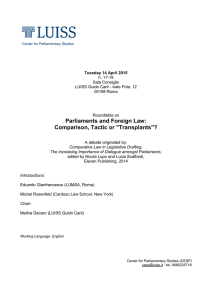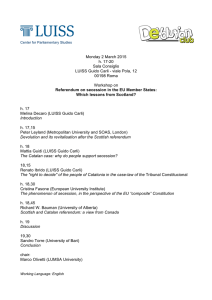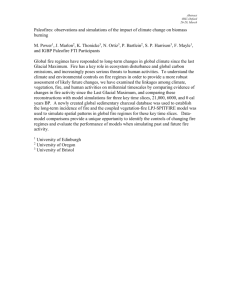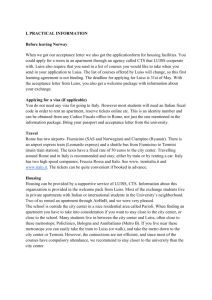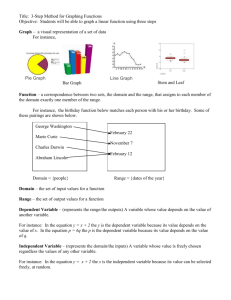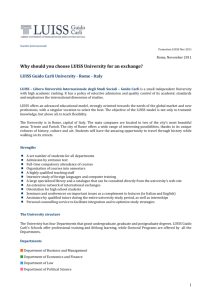political risk: concepts, definitions, challenges
advertisement
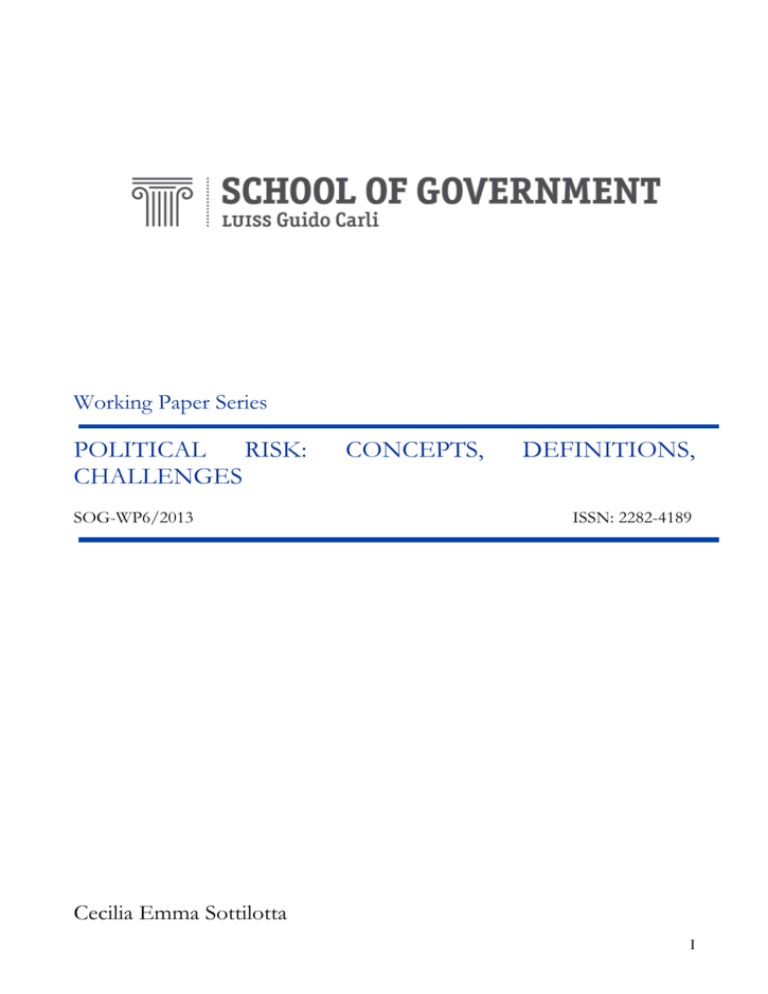
Working Paper Series POLITICAL RISK: CHALLENGES SOG-WP6/2013 CONCEPTS, DEFINITIONS, ISSN: 2282-4189 Cecilia Emma Sottilotta I This text may be reproduced only for personal research purposes. Additional reproduction for other purposes, whether in hard copies or electronically, requires the consent of the author(s), editor(s). If cited or quoted, references should be made to the full name of the author(s), editor(s), the title, the working paper, or the other series, the year and the publisher. © 2013 Cecilia Emma Sottilotta Printed in Italy, April 2013 LUISS School of Government Via di Villa Emiliani, 14 00197 Rome ITALY email: sog@luiss.it web: www.sog.luiss.it II ABSTRACT The present paper provides a synthetic overview of the history and latest developments in the field of political risk assessment for foreign investors. After reviewing the numerous definitions of political risk existing in the literature, “macro” and “micro” approaches to political risk assessment are discussed, with the purpose of highlighting their shortcomings and providing cues for discussion and further research. This version was circulated in occasion of the LUISS School of Government Annual Conference held on December 14th 2012, and dedicated to “Investing in the Age of Political Risks”. Keywords: Political Risk, Foreign Direct Investment, Political Stability, Country Risk AUTHOR INFORMATION Cecilia Emma Sottilotta is a Ph.D. candidate in Political Theory at LUISS Guido Carli. Contact Information: LUISS School of Government, Via di Villa Emiliani, 14, 00197 Rome - Italy Tel. +39-06-85225051 Fax +39-06-85225056 Email: sog@luiss.it Website: www.sog.luiss.it III TABLE OF CONTENTS 1. Introduction ............................................................................................................... 1 2. Political risk: a fuzzy concept ................................................................................... 2 3. Definitions: a review ................................................................................................. 3 4. Approaches to macro political risk assessment ......................................................... 7 5. Approaches to micro political risk assessment ......................................................... 9 6. The role of human judgment: measuring the unmeasurable?.................................. 11 7. Conclusions ............................................................................................................. 13 8. Bibliography & References ..................................................................................... 15 IV 1. Introduction What is political risk, and what is the best way to assess it? Although risk calculation has always been part of any business venture, it was only after the Second World War, especially in relation with the relevant outflow of capital from the US to Europe, that political risk analysis began to be developed as such. The concept of political risk was introduced as a component of country risk, in order to account for the causes of the insolvency of a country, not directly linked to financial/economic factors. Political risk gained more and more relevance in the following decades, as several institutions started to develop specific methodologies in order to evaluate it, trying to keep pace with the fastchanging dynamics of the internationalisation of trade and investment. According to the World Investment Report 2012, although the current perspectives of transnational investment remain fraught with risks deriving from multiple sources, global foreign direct FDI flows exceeded the pre-crisis average in 2011, reaching $1,5 trillion, with greenfield investments accounting for almost two-thirds total FDI1. Even more than portfolio investment, FDI – especially when taking the form of greenfield investment – entails a careful consideration of the possible political scenarios in the host country: it therefore comes as no surprise if in recent years political risk analysis has come to the fore as an essential tool for executive decision-making, regardless of the dimensions of the business. In addition, a plethora of other actors perform political risk analysis for investment-related purposes, from consulting firms to export credit agencies, from rating agencies to insurance companies. Diversity in the nature of the actors performing political risk analysis is matched by the many diverse meanings attached to this catchall term. Partly due to its intrinsically interdisciplinary nature, political risk as such has been neglected as a subject of study in the context of academic political science, despite the tradition of studies on the variously defined concept of “political instability”. When information on political risk is gathered, elaborated and provided to multinational investors in the context of political insurance industry, comparisons between the different political risk assessment approaches and relative indexes are not easy to carry out, for evident reasons of competition. This explains the lack of transparency in the field, which prompts to question the logic and practice underpinning the existing political risk indices. It cannot but be acknowledged that, for example, despite some interesting contributions in the last years (see in particular JENSEN, 2003 and 2008) the relationship between political regimes 1 UNCTAD, World Investment Report 2012 1 proper and political risk remains largely unexplored. Therefore, a reappraisal of political risk conceptualization and measurement seems timely today. This paper, drawn up in occasion of the LUISS School of Government 2012 annual conference dedicated to “Investing in the age of Political Risks” aims at providing a state of the art of the discipline, highlighting the different meanings and relevance that political risk analysis assumes nowadays with respect to different typologies of investors. Finally, it aims at individuating some questions which will hopefully serve as cues for further discussion. 2. Political risk: a fuzzy concept Although risk assessment in terms of political environment has always been part of any business venture2, the reception of political risk in economic and financial literature only dates back to the 1960s. The conceptual boundaries of political risk have always been hazy, as testified by the fact that starting from the 1970s, the scholarship on political risk features many literature reviews trying to grab hold of this ambiguous concept (e.g. Kobrin 1978, Fitzpatrick 1983, Simon 1984, Friedman 1988, Chermack 1992, Jarvis 2008). Yet, as a first step in trying to achieve more clarity in this field, it is possible – and useful to the purposes of this research – to analyse the use of the term in its historical evolution. In 1960s, when financial and economic actors began to develop country risk analysis, the political scenario worldwide was shaped by two complex and intertwining processes: the Cold War, with the ideological contrast between capitalism and socialism, i.e. free market and planned economies, and the beginning of decolonization. The likelihood of events – such as the 1956 Suez crisis or the 1960 Congolese one – that could suddenly and drastically change the political as well as the business environment increased. Political risk, however, sometimes also referred to as “noneconomic risk”3, was predominantly considered to be a feature of “underdeveloped” or “modernizing” countries (Zink 1973, Green 1974, Green and Korth 1974): as Jodice put it, first generation political risk analysts were mostly concerned about investment disputes deriving from the so-called “economic nationalism”, i.e. the trend, typical of developing countries, to confiscate or expropriate foreign property in the name of public interest (Jodice 1985 : 9). The 1970s were marked by two events, both – unsurprisingly – with a relevant impact on the 2 For an historical account of country risk in the late19th -early 20th century, see Ferguson,Niall and Schularick, Moritz 2004. The Empire Effect: The Determinants of Country Risk in the First Age of Globalization, 1880-1913, Working Papers 04-03, New York University, Leonard N. Stern School of Business, Department of Economics. 3 See for instance Mayer (1985) : 10. The author surveys the (more or less) structured systems used by banks and other entities to assess country risk (and political risk as a part of it) 2 perception of political risk by the business world: the 1973 oil-shock and the 1979 Iranian revolution. The occurrence of such grand scale events highlighted the importance of political risk assessment and management, and the political risk industry began to flourish, with the proliferation of consulting firms as well as of applications for political risk coverage, provided both by public and private insurers (Simon 1984). The 1980s saw another shift in the connotation of political risk, with a focus on the problem of debt management by host countries . During the 1990s, instead, and even more so after the attacks to the World Trade Center in New York City, terrorism has become a source of concern of international investors, and has entered the scene as a form of political risk (Berry 2010). The scope and breadth of political risk analysis has also evolved in geopolitical terms – from the observer's standpoint – from being mostly performed by and in the interest of western (mostly American) MNEs, to being a truly global activity. Emerging markets firms invest in risky markets more than their global counterparts (Satyanand 2011), and in light of the financial (and political-economic) crisis started in 2008, developed countries do not look as rid of risk for foreign investors as in the past. Thus, political risk is not any more seen as an exclusive attribute of “least developed countries” ( LDCs). Generally speaking, it can be said that the term political risk has come to designate a component of country risk, the latter being defined as “the ability and willingness of a country to service its financial obligations” (Hoti and McAleer 2003:1). However, it should also be noted that “country risk” today commonly refers to a wider array of risks, not only of financial but also operational in nature : “country risk is of a larger scale, incorporating economic and financial characteristics of the system, along with the political and social, in the same effort to forecast situations in which foreign investors will find problems in specific national environments” (Howell 2007:7). 3. Definitions: a review In an attempt to classify the alternative “technical” meanings that have been attached to political risk over time, the following definitions were identified: 1) political risk as non-economic risk (Meyer 1985, Ciarrapico 1984); 2) political risk as unwanted government interference with business operations (Eiteman and Stonehill 1973, Aliber 1975, Henisz and Zelner 2010); 3) political risk as the probability of disruption of the operations of MNEs by political forces or events (Root 1972, Brewers 1981, Jodice 1984, MIGA 2010); 4) political risk as discountinuities in the business environment deriving from political change, which have the potential to affect the profits or the objectives of a firm (Robock 1971, Thunell 1977, Micallef 1982); 5) political risk substantially 3 equated to political instability and radical political change in the host country (Green 1974, Thunell 1977 ). The first definition is typical of an initial phase in which firms and banks began to address the problem of assessing risks that could not be classified as mere business risks, nor could be evaluated by looking at the economic fundamentals of a country. The second definition is quite restrictive, and it has relevant normative implications, as noted by Kobrin (1979), because it assumes that government intervention is necessarily harmful, i.e. that host government restrictions on FDI involves economic inefficiency. This is not always true, and in political risk assessment the (not necessarily) diverging objectives of companies and host governments should be analyzed as such, in order not to be mislead by preconceptions. It could be added that, in light of the debacle of the “Washington consensus” and also considering the financial and economic crisis started in 2008 (which exposed the risks implicit in the under-regulation of markets), the concept of government laissez-faire has lost much of its appeal to business theory and practice. The third definition is perhaps the most precise from the semantic point of view, because it correctly does not consider political risk in terms of events, but rather in terms of probability of events (harmful to MNEs operations). If the aspect of probability calculation is overlooked, by conceptualizing political risk in terms of mere “events”4 which can have an impact on the firm, one risks to behave like the proverbial fool that when a man points at the moon, only looks at his finger. Political risk calculation is an intrinsically forward-looking task, and political risk may well be structurally high, and be perceived as such by a firm, even in the current absence of possibly harmful events. The fourth category of definitions is broader, since it focuses on the “business environment” rather than on the individual firm. The influential definition by Robock (1971:7) deserves a closer look: “Political risk in international business exists (1) when discontinuities occur in the business environment, (2) when they are difficult to anticipate (3) when they result from political change. To constitute a risk these changes in the business environment must have a potential for significantly affecting the profit or other goals of a particular enterprise”. The idea of an existing, observable discontinuity in the business environment is quite common in definitions of political risk. Once again, it is important to underscore a point: even situations which apparently look stable (and that have been so for a relatively long time) may be extremely risky. The notion of latent variable in statistics effectively illustrates this concept 5. Risk can be 4 See for instance Ekpenyong and Umoren (2010, : 28), who define political risk as “any politically induced event that has destabilizing effects on the polity, and distorts the functionality of an enterprise.” 5 A very clear statistical treatment of the subject can be found in Scott Long (1997) 4 thought of as the likelihood of a certain event to take place. What is subsequently observed is, in fact, a binary outcome: either the event takes place, or it does not. The idea of latent variable is that there is an underlying propensity for the event (say, a general strike, a revolution or a mere act of expropriation) to occur, that generates it. The political scenario in a country may look stable because it actually is stable, or, paradoxically, it can look stable in a given moment notwithstanding the fact that the political regime in force is about to collapse. In the wake of the Iranian revolution and of the Soviet invasion of Afghanistan, for instance, Brewers rightly pointed out that “the past stability of an authoritarian regime should not be taken as a predictor of future stability” (Brewers,1981, : 8). This lesson has proved valid also for the Middle-East and North-Africa (MENA) countries which experienced drastic political change in the form of revolution in early 2011. Robock also introduced a distinction that is particularly salient to this analysis, i.e., the distinction between “macro” political risk (when political changes are directed to all foreign enterprise) and “micro” political risk (when changes are selectively directed towards specific fields of business activity). Evidently, micro political risk assessment should be performed at the industry – or even at the firm – level, while, as emerging from the present analysis, when they write about “political risk” in general, most authors refer to macro political risk. The fifth group of definitions was basically developed by authors who aimed at bridging the gap between political science and business studies, building on the scholarship on political change. Green's contribution was the first to focus on the relationship between the type of political regime and political risk (Green 1972 and 1974). Seven types of regime are individuated, with a growing level of risk: Instrumental Adaptive (e.g. US, UK) and Instrumental Non-adaptive (e.g. France, Italy), which are labeled as “modernized nation-states”; Quasi-Instrumental (e.g. India, Turkey) , Modernizing Autocracies (e.g. Syria, Jordan), Military Dictatorships (e.g. Burma, Lybia), Mobilization Systems (e.g. China, Vietnam, Cuba, North Korea) and Newly Independent (e.g. Indonesia, Ghana), which are defined as “modernizing nation-states”. Green's approach rests on a number of assumptions. The first is that radical political change is intrinsically detrimental to the activity of MNEs. The second is that the younger the political system, the less it is “adaptive” to change, and thus the higher the risk of radical political change. The third is that economic modernization inevitably puts the political system under stress, and that the political institutions in modernizing states must either change or be replaced. Although, as already pointed out, it interestingly focuses on the origins of political risk in terms of political regime structures, this analysis has little empirical foundations and does not delve into the specific mechanisms linking the different kinds of political regimes and political risk. 5 Before concluding this section, it is worth adding a few remarks. Today more than in the past, the task of political risk conceptualization and assessment is performed by private or public agencies (Business Environment Risk Intelligence, Control Risks, Eurasia Group, the Multilateral Investment Guarantee Agency in the World Bank Group, Oxford Analytica, Political Risk Services Group, to name only some of them). As a matter of fact, most of them do not disclose, if not to a very limited extent, their methodology for risk-assessment, nor they seem to agree on a precise definition of what a political risk is to the purposes of their activities. This aspect is particularly relevant because the lack of transparency in definitions and criteria for measurement is one of the reasons why the realm of political risk assessment is often dismissed as a “soft science”. It is possible to draw some provisional conclusions from what said so far. First, that despite several decades of scholarly endeavours, political risk in international business and in political science seems to be affected by conceptual confusion. Second, that in light of the renewed interest of scholars and practitioners in the subject, a reappraisal of political risk from the conceptual point of view seems timely. Third, that no author, except Green (1974) and, more recently, Jensen (2003 and 2008) has specifically analysed political risk in relation with political regimes. As Sethi and Luther pointed out, “...It seems that in much of the research effort on political risk, not enough attention has been paid to the development of concepts and definitions that capture the breadth of the problem. Unless the definitions are clear, other methodological issues are not likely to be resolved”(Sethi and Luther 1986:58). As Jarvis and Griffiths put it, the 1980s marked a renounce, by political risk analysts, to such a “systemic” approach, mostly because it seemed to be inevitably plagued by a circular logic: “Low political risk and high political stability are manifest in systems that are developed, predominantly Western, liberal democratic, and capitalist. By definition, any state that displays dissimilar characteristics represents a political risk and the possibility of instability” (Jarvis and Griffiths 2007:15). Nonetheless, the political and economic upheaval following to the financial crisis has proven that not only Western, liberal democratic and capitalist countries are not rid of political risks for foreign investors, but, on the contrary, they can indeed generate such risks. As already hinted at, a reappraisal of the concept and definition of systemic political risk from the point of view of empirical political science therefore seems timely. In particular, political risk could be defined as the probability that the profitability of an investment be negatively affected by circumstances ascribable either to unforeseen changes (e.g. revolutions, even when linked to democratization processes) in the domestic or international political arena, or to governmental policy choices affecting the international investor's property rights. In both cases, risk analysis 6 would need to be conducted carefully by looking through the lenses of domestic political regimes, on the one hand, and of international factors. The role and operationalization of the latter deserve a closer look in terms of future research agenda. In fact, as far as the external or “international” dimension of risk is concerned, which some have conceptualised in terms of “bad neighbourhood”6 there seems to be room for improvement and contributions from international relations theory. 4. Approaches to macro political risk assessment As already clarified, country risk refers to the analysis of the creditworthiness of a country. A number of well-established indicators and techniques have been developed over time to this purpose. Among the first, there are ratios such as capital inflows/debt service payments, debt service payments/external debt, External debt/GDP, as well as the default history of a country7. As far as the second are concerned, the methodologies used include logit/probit analysis, regression analysis, Monte Carlo simulations, value at risk and principal components analysis, non-parametric methods such as neural networks8. Nonetheless, when it comes to political risk, in most cases a purely quantitative approach is not possible. Events which are political in nature, such as revolutions, terrorist attacks, an abrupt changes in tariffs or acts of expropriation, are generally much more difficult to predict than sovereign default. Human judgment, therefore, plays a central role in political risk analysis. Looking at the historic evolution of political risk assessment and monitoring, after surveying a number of American MNEs, Rummel and Heenan (1978) found that four methods were mostly used for political risk analysis:“grand tours”, “old hands”, “Delphi techniques” and “quantitative methods”. The first category encompasses efforts by companies to get a sense of the political and business climate recurring to company representatives’ visits to the potential host country. The second basically consists in looking for unstructured advice from experts (such as diplomats, journalists, executives with experience in the country in question). The third category comprises the Delphi techniques, developed by RAND Corporation in the 1960s, opinion to used to aggregate expert obtain overall indices or measures of political risk9. Finally, the fourth category embraces quantitative studies aiming at uncovering political trends resorting to multivariate data 6 As in the case of the EIU Political Instability Index 2009-10, see http://www.economist.com/node/13349331 (accessed in November 2012) 7 For a comprehensive list of country risk indicators, see Kosmidou, Doumpos, Zopounidis, Country Risk Evaluation – Methods and Applications, Springer Optimization and Its Applications, Vol. 15 (2008)p. 3 8 See M.H. Bouchet, E. Clark, B. Groslambert, Country Risk Assessment: A Guide to Global Investment Strategy, Wiley Finance Serie (2003), ch. 6 9 PRS Group, for instance, uses a modified Delphi technique to obtain its country ratings. For an overview, see H.A. Linstone and M.Turoff, Delphi Method: Techniques and Applications, Addison-Wesley Educational Publishers Inc (December 1975) 7 analysis (the authors recall how data on Soviet weaponry was useful to help predicting the end of detente in mid-1970s). Although the techniques listed are still widely used today, in the last decades the field of political risk has witnessed changes and evolutions. A fifth category of approaches can be added, with reference to efforts aimed at modelling risk on the basis of assumptions about the causal relationship linking some features of the political environment to the likelihood of political risk events. Such models are used to perform scenario analysis and to provide aggregate measures of political risk. For instance, building on the work of Robock (1971), Haner (1979), Simon (1982) and Alon (1996), Alon and Martin (1998) present a model of macro political risk assessment based on an overarching discrimination between internal and external sources of risk, and a further distinction between societal, governmental and economic factors (internal government-related factors, for instance, include “degree of elite repression”, “degree of elite illegitimacy” , “likelihood that regime change will affect economic policy”, each of which can be assigned a score ranging from “ - 2” to “+2” – the higher the score, the lower the risk). Brink (2004) proposes a model based on three main dimensions, “political risk” (including 37 indicators), “economic risk” (41 indicators) and “social risk” (25 indicators), each of which can be dropped or weighted differently according to the user's needs. Many consulting firms use models similar to the ones described. This is the case, for instance, of the model developed by Coplin and O’Leary, used by PRS Group to provide differentiated risk forecasts for three categories of investment: financial transactions, FDI and exports, with two different time horizons (18 months and 5 years), based on the estimation by country experts of the three most likely future regime scenarios10. PRS Group also produces the “International Country Risk Guide” (ICRG) country ratings based on three categories of risk: political, financial and economic. The Political Risk Rating, which accounts for the 50% of the overall index, includes 12 weighted variables covering the following political and social attributes: government stability, socio-economic conditions, investment profile, internal conflict, external conflict, corruption, military in politics, religious tensions, law and order, ethnic tensions, democratic accountability, bureaucracy quality. Variously designed political risk indices and models developed by other bodies and consulting firms, such as Business Environment Risk Intelligence (BERI) Political Risk Index, the Economist Intelligence Unit (EIU) Political Instability Index, EURASIA's Global Political Risk Index, share some basic features with the three models described above, namely the reliance on the judgment of country experts, and the subjectivity of the weights assigned to risk factors and indicators. 10 See http://www.prsgroup.com/PRS_Methodology.aspx (accessed in November 2012) 8 One of the most relevant problems associated with political risk ratings is that of their effectiveness: how is it possible to “assess the assessment techniques”? The question is thorny for a number of reasons. First of all, comparisons are not easy to carry out because of evident reasons of competition: most ratings are provided by private consultants or in the context of political risk insurance and as such are not open for scrutiny. Second, even when they are, it is not easy to quantify politically motivated losses incurred by companies, in order to put them directly in relation with past political risk ratings and test their predictive power against actual losses. A few studies took up the issue of political risk modelling assessment. In a path-breaking work in this field, Howell and Chaddick conducted a comparison across three different approaches to political risk assessment, building a “loss index” based on OPIC's record of payments for claims related to expropriation, inconvertibility, war damage, and civil strife damage, and on information drawn from “Foreign Economic Trends,” news reports, and corporate reports or interviews. (Howell and Chaddick, 1994:73). The predictive power of political risk indices for the period 19871992 was then tested against the loss index resorting to multiple correlation and stepwise regression. An attempt at replicating the study for the period 1994-2004 was made by Nel (2009) but with diverging results compared to the original11. The problem, however, is the general lack of available data, not only as far as losses are concerned, but also as regards country ratings. In a comparative analysis of country risk ratings, Oetzel, Bettis and Zenner solve the first problem by using currency fluctuations as a surrogate for overall country risk. However, although their original intention was to compare eleven country risk measures across seventeen countries during a period of nineteen years, the researchers were compelled to limit their study to four out of eleven measures12, among the other reasons, “either because it was cost prohibitive to purchase them (…) or because access was limited by the publisher” (Oetzel, Bettis and Zenner 2001: 134). 5. Approaches to micro political risk assessment Definitional confusion and lack of data affect macro political risk models, like the ones described above, as well as sector-specific and even firm-specific models. In this respect, it is important to recall that distinctive approaches depend not only on the dimension of the firm, but also on the business sector they belong to. For instance, political risk 11 Such differences might be explained by the partially different research design and country sample. Bank of America World Information Services, Business Environment Risk Intelligence (BERI) S.A., Control Risks Group (CRG), the Economist Intelligence Unit (EIU), Euromoney Magazine, Institutional Investor Magazine, International Country Risk Guide (ICRG), Moody’s Investor Service, Political Risk Services, S.J. Rundt & Associates, Standard & Poor’s Ratings Group 12 9 analysis has typically been a major concern for energy and natural resources companies, which are characterized by high sunk costs and which face unavoidable constraints as to the choice of the countries where to operate. In this sector, risk avoidance is often not an option, and the only possibility left might be trying to build up an adequate risk mitigation strategy. Natural resources companies have always been exposed, in particular, to the risk of expropriations and nationalizations (as happened on a massive scale in the 1970s). Although losses related to expropriation episodes have declined over time (the World Bank reports 423 cases of expropriation of foreign assets in the 1970s, against 17 during 1980-1987 and zero between 1987 and 199213), more subtle forms of expropriation have witnessed a surge in the last years, assuming the physiognomy of “creeping expropriation”, e.g. in the case of increasing tax rates on profits, which affect the profitability of the business over time14. The vulnerability of the energy sector to political risk is also well exemplified by the losses incurred by natural sources companies during the Arab Spring, which swept across the Middle-East and North Africa (MENA) region starting from January 201115. Banks represent yet another crucial actor with a specific standpoint on the matter. Political risk in the banking context can be defined as “(…) The risk that cash flows accruing to a country’s banks and bank investors will be adversely affected by changes in government policy that are independent of monetary policy considerations” (Simpson 2007 : 14). While also in this field political risk has often been assimilated to country/sovereign risk, there is a growing consciousness that it deserves specific attention16. Moreover, although certain typologies of risk affect the business environment in general, there are specific risks likely to affect the financial sector in an almost exclusive fashion: with the financial crisis started in 2008, in which big commercial banks have been in the eye of the hurricane, political risk in the form of normative activity by governments aimed at regulating aspects such as capital adequacy requirements, bank reserves requirement (not to mention the much debated “Tobin tax” proposals) has witnessed a dramatic escalation. Specific risk models have been developed in the banking sector, such as the CAMEL model, based on the assessment of capital adequacy, asset quality, management quality, earnings, and liquidity, the Zonis model, based on three broad indices (Political Stability Index, Policy Foundations Index, Institutional Strengths Index) and the Bank of America model, based on ten 13 MIGA Report on World Investment and Political risk (2009), MIGA- The World Bank Group, p. 28 Episodes of plain expropriation still occur today, as in the recent case of the Spanish Repsol Argentine subsidiary YPF, nationalized in April 2012 (see Argentina announces expropriation of Repsol oil subsidiary YPF, EL PAIS, Francisco Peregil, Madrid/Buenos Aires April 17th 2012) 15 In this sense, suffice it to recall that OECD European countries imports of crude oil, natural gas liquids and refinery feedstocks from Lybia dropped from 57.151 thousand metric tons in 2010 to 15.290 in 2011 (reaching a low peak of 223 in the third quarter of the year, according to the International Energy Agency Monthly Oil Survey, July 2012), reflecting a dramatic drop in oil production which lasted for several months, due to the turmoil which culminated in the end of the 30-years rule of Muammar Gaddafi. 16 See for instance English, Kari, Add Political Risk to Bankers' Management Duties, Bank News 109. 12 (Dec 2009): 28-29. 14 10 variables: GDP per capita, real GDP growth, nominal GDP, trade balance, current account balance, gold reserves, external debt, money growth, consumer price inflation, and exchange rate (Alon, Gurumoorthy, Mitchell, Steen 2006 : 629-30). To sum up, the problem of the standpoint from which political risk assessment is performed is crucial (generalist vs. firm-specific and even project-specific approaches) and has an obvious impact on the methods and techniques chosen. The methodological implications of the level at which the analysis is performed, i.e. whether one is dealing with “macro” or “micro” political risk, to use Robock’s taxonomy, are evident: while an index-based approach is indispensable to provide a cross-country risk overview, and is necessary, for instance, for insurers or ECAs to establish to which class of risk a country belongs, at the lower extreme of this “ladder of generality” lay microrisk approaches focusing on individual projects. Micro political risk assessment also needs to take into account the stage of the investmentrelated decision making process. The initial stage, for instance, might imply the need to choose in which market to invest and in this case a general, cross-country approach might be the most appropriate one. Once the decision has been made, and the operational phase of the investment starts, another approach is required, focused on monitoring rather than rating countries. Finally, it is worth noticing that when dealing with “micro” political risk, another definition can be recalled, which constitutes a radical departure from risk as treated here: political risk is sometimes referred to as the risk of non re-election of political leaders. For instance, Althaus (2008), in her volume “Calculating Political Risk”, defines political risk as the calculation that political actors (of western liberal-democracies) make before promoting a certain policy- i.e. the calculation of the “political cost” of decisions in terms of loss of votes in future elections. 6. The role of human judgment: measuring the unmeasurable? An important remark has to be made at this point. Be they generalist or sector/firm/ project specific, efforts aimed at measuring and modelling political risk cannot but rely on human judgement, which plays a crucial role both in designing models and in the concrete rating “soft” variables which cannot be measured otherwise. In the end, the probability of a harmful event derives from a judgement that “converts a political uncertainty into political risk” (Root 1972 :57). Models for political events forecasting are only as good as the information they factor in – paradoxically, even the ideal model, taking into account the truly relevant variables to devise the best risk mitigation strategy, would be completely useless if the“raw data” about those variables were flawed. 11 Although this issue is often forgotten or ignored by practitioners, political risk assessment epitomizes the much-debated problem of measurement in social sciences17. Translating abstract concepts into numbers, and doing so effectively, requires first of all a clarifying effort since “concept formation stands prior to quantification”, to recall Sartori's famous warning (Sartori 1970), and then, inevitably, a careful validity and reliability check (Jackman 2008). Validity refers to the subject of measurement, and it is closely linked to the question of concept formation: when measuring political risk, what are we exactly measuring, i.e. which causal relations are we postulating between the abstract concept (e.g. “the risk of losses due to political causes”) and the underlying indicators we choose to include in our model? A valid model is the one that “hits the target”, and therefore it cannot exist without an unambiguous definition of the target itself. Reliability, on the other hand, refers to the variability of the measurement, its repeatability and consistency. Indeed, is not possible to ignore the limits of expert political judgement18. However, it can be argued that political risk assessment techniques would greatly benefit from a general reflection on the process of judgemental data construction. Schedler effectively summarizes the terms of the question by calling for “common standards and operating procedures” in five crucial areas: expert selection, measurement comparability, transparency, convergence, and accountability (Schedler 2012: 31). In the end, assuming that one of the most important issues in political risk measurement is the quality of expert judgement, it has to be recognised that it depends heavily on the background of the expert panel (what is it meant exactly by “expert”? Are criteria for expert selection thoroughly codified?), on the comparability of ratings (are there explicit, shared standards for such ratings? Are response-style adjustment techniques adopted?), on the overarching issue of transparency (the lack thereof in the field of political risk assessment has already been underscored), on convergence (how are final figures measuring risk components obtained? As hinted at above, Delphi techniques are widely used, but other methods are also available, e.g. deliberative procedures to reach consensus, unstructured face-to-face meetings, the nominal group technique and the so-called prediction markets19), and, finally, on accountability, which necessarily entails efforts, such as the ones prescribed by Tetlock, aimed at testing expert performance against “standardized baseline measures of forecasting accuracy and timeliness of belief updating” (Tetlock 2005:234). 17 See for instance King, Gary, Robert O. Keohane, and Sidney Verba (1994)Designing Social Inquiry: Scientific Inference in Qualitative Research. Princeton, NJ: Princeton University Press and Brady, Henry E. and David Collier, eds. 2004. Rethinking Social Inquiry: Diverse Tools, Shared Standards. Lanham, MI:Rowman & Littlefield 18 See Tetlock (2005) 19 For an overview of these techniques, see Graefe and Armstrong (2011) 12 7. Conclusions Political risk assessment is today a task of paramount importance for the international investor. While in the past political risk was often conceptualised in terms of hostile action by host countries' governments, with the quick pace of globalization its nature and sources have considerably changed, raising the interest of scholars belonging to different fields, from international economics to international relations, from empirical political science to psychology and decision theory. In an era in which global equilibria have changed and once clear-cut distinctions such as “developing” vs.“developed” countries have become blurred, intelligence and risk management have become a major source of concern. The issue of the relationship between politics and the activity of international investors has become even more burning in light of the ongoing economic and financial crisis, a crisis whose causes are – at least partially – ascribable to questionable policy choices. From an overview of political risk literature, some issues clearly emerge: first of all, given the multitude of meanings attached to this term, there is still confusion about what political risk exactly is, and what is the best way to assess it. This holds true at every level of analysis, be the approach based on “micro”or “macro” political risk. A major challenge in this respect regards the question of how to design and conduct meta-studies of political risk assessment methodologies. For the reasons outlined above, in most cases opacity persists around the choices underlying the construction of models, as well as around the production and processing of the information that models factor in. In other words, how is it possible to better organise knowledge for predictive purposes, in a field that has often be regarded as an “art” more than a “science”? Is there a way to reach a higher level of transparency? It is worth noting that comparing political risk models and indices would be important also to avoid the problem of circularity in studies investigating various aspects of political risk itself: suffice it to mention that numerous works make use of the same political risk data, and their findings in the end rely on the validity of such data (see, for instance Erb, Harvey, and Viskanta,1996, Diamonte, Liew, and Stevens 1996, Oetzel, Bettis, and Zenner, 2001, Simpson, 2007, Click and Weiner, 2010). Finally, another question regards the possible contribution of political science to political risk analysis. As already hinted at, the literature exploring the relationship between domestic political regimes and political risk is scant. Compared to the past, relatively few authoritarian regimes remain in place. A large share of regimes worldwide can be classified as either democratic, or hybrid (Diamond 2002, Morlino 13 2009). Moreover, also (but not only) in light of the last wave of democratic change which swept across the Middle-East, it can be argued that there is a relationship between democratization processes and political risk, and future research should focus on it. In particular, it would be worth testing the hypothesis that a few key, aspects of the rule of law, often associated with the assessment of the “quality of democracy” as elaborated in Morlino (2011), can be applied more broadly, including to democratising and even to non-democratic regimes, to provide key indicators of political risk. Since different regimes seem to pose different challenges for the foreign investor, looking at political risk through this lens might help develop tools capable of more reliable and refined assessments. 14 8. Bibliography & References Aliber, R. A. (1975) Exchange risk, Political Risk and Investor Demands for External Currency Deposits. Journal of Money, Credit and Banking (7) 161-179 Alon, Ilan, (1996) The nature and scope of political risk, In E.W. Stuart, K.J. Ortinau, E.M.Moore (eds.) Marketing: Moving toward the 21st century. Rockhill, South Carolina: Southern Marketing Association, 359-364 Alon, Ilan and Martin, Matthew A., (1998) A Normative Model of Macro Political Risk Assessment, Multinational Business Review, Fall, 6, 2 pp. 10- 20 Alon, I., Gurumoorthy, R., Mitchell, M. C., & Steen, T. (2006) Managing Micropolitical Risk: A Cross-Sector Examination,Thunderbird International Business Review, 48(5), 623—642. Althaus, Catherine (2008) Calculating Political Risk, London: Earthscan Beck, Ulrich, (1992) Risk Society: Towards a New Modernity, Sage Publications Ltd. Berry, Charles (2010) The Convergence of the Terrorism Insurance and Political Risk Insurance Markets for Emerging Market Risk: Why It is Necessary and How It Will Come About in Moran,Theodore H. , West,Gerald T. , Martin, Keith (Eds.) International Political Risk Management - Needs of the Present, Challenges for the Future, The World Bank: Washington D.C. Brady, Henry E. and David Collier, eds, (2004) Rethinking Social Inquiry: Diverse Tools, Shared Standards. Lanham, MI : Rowman & Littlefield Brewers, Thomas L.,(1981) Political Risk Assessment for Foreign Direct Investment Decisions: Better Methods for Better Results, Columbia Journal of World Business (Spring), pp. 5-12 Brink, Charlotte (2004), Measuring Political Risk: Risks to Foreign Investment, Ashgate Publishing, Ltd. Chermack, J.M. (1992) Political Risk Analysis: Past and Present, Resources Policy, September, pp. 167 -178 Ciarrapico, Anna Micaela (1992) Country risk: a theoretical framework of analysis, Aldershot ; Brookfield : Dartmouth. Click, Reid W; Weiner, Robert J., (2010) Resource nationalism meets the market: Political risk and the value of petroleum reserves, Journal of International Business Studies, suppl. Part Special Issue: Conflict, Security, and Political Risk: 41. 5 (Jun/Jul): 783-803. Diamond, Larry Jay, (2002) Thinking About Hybrid Regimes, Journal of Democracy, Volume 13, Number 2, April, pp. 21-35 Diamonte, R.L., J.M. Liew and R.L. Stevens (1996), Political Risk in Emerging and Developed Markets, Financial Analysts Journal, 71-76. Eiteman, David K., and Stonehill, Arthur I.(1973), Multinational Business Finance, AddisonWesley Educational Publishers Inc. Ekpeyong, David B. and Umoren, Ntiedo J.,(2010) Political Risk and The Business Environment:An Examination of Core Challenges, Journal of Financial Management and Analysis, 23(l):27-32 15 Erb, Claude B., Harvey, Campbell R., Viskanta, Tadas E. (1996) Political Risk, Economic Risk and Financial Risk, Financial Analysts Journal – November/December Fitzpatrick, Mark, The Definition and Assessment of Political Risk in International Business: A Review of the Literature, Academy of Management Review. 1983, Vol. 8, No. 2, 249-254. Friedman, Roberto and Kim, Jonghoon, (1988) Political Risk and International Marketing, Columbia Journal of World Business, (Winter), pp.63-74 Giddens, Anthony (1999) Runaway World: How Globalization is Reshaping Our Lives. London: Profile. Graefe, Andreas and Armstrong, J. Scott (2011) Comparing Face-To-Face Meetings, Nominal Groups,Delphi And Prediction Markets On An Estimation Task, International Journal of Forecasting 2, pp. 183–195 Green, Robert T. (1972) Political Instability as a Determinant of U.S. Foreign Investments, Studies in Marketing, No. 17, Bureau of Business Research, Graduate School of Business, University of Texas at Austin Green, Robert T. (1974) Political Structures a a Predictor of Radical Political Change, Columbia Journal of World Business, Spring: 28-36 Green, Robert T. and Korth, Christopher M. (1974) Political Instability and the Foreign Investor, California Management Review, Fall 18 (1):23-31 Haner, F. T. (1979) Rating investment risks abroad, Business Horizons, 22:18-23. Henisz , Witold J.and Zelner , Bennet A.(2010) The Hidden Risks in Emerging Markets, Harvard Business Review, April Hoti, Suhejla and McAleer, Michael, (2004) An Empirical Assessment of Country Risk Ratings and Associated Models, Journal of Economic Surveys, Wiley Blackwell, vol. 18(4), pages 539-588, 09 Howell, Llewellyn D, Chaddick, Brad,(1994) Models of Political Risk for Foreign Investment and Trade - An Assessment of Thee Approaches, The Columbia Journal of World Business, Volume: 29, Issue: 3, pp. 70-91 Howell, Llewellyn D., (2007) Country and Political Risk Assessment for Managers, in Howell, Llewellyn D. (ed.) The Handbook of Country and Political Risk Analysis (4th Edition) The PRS Group, Inc. Hurwitz, Leon (1973) Contemporary Approaches to Political Stability, Comparative Politics, Vol. 5, No. 3, Special Issue on Revolution and Social Change (April):449-463 Jackman, Simon (2008) Measuremen,. In The Oxford Handbook of Political Methodology, eds. Janet M. Box-Steffensmeier, Henry E Brady, and David Collier. Oxford: Oxford University Press. Jarvis, D. S. L.,(2008) Conceptualizing, Analyzing and Measuring Political Risk: The Evolution of Theory and Method, Lee Kuan Yew School of Public Policy Research Paper No. LKYSPP08-004. Available at SSRN: http://ssrn.com/abstract=1162541 or http://dx.doi.org/10.2139/ssrn.1162541 16 Jarvis, Darryl and Griffiths, Martin, (2007) Learning to Fly: the Evolution of Political Risk Analysis, Global Society, Volume 21,Number 1, January 2007, pp. 5-21 Jensen, Nathan M. (2003) Democratic Governance and Multinational Corporations: Political Regimes and Inflows of Foreign Direct Investment, International Organization 57 (3): 587-616. Jensen, Nathan M. (2008) Political Risk, Democratic Institutions, and Foreign Direct Investment , in The Journal of Politics, Vol. 70, No. 4, October, Pp. 1040–1052 Jodice, David A. (1984), Trends in Political Risk Assessment: Prospects for the Future, in Fariborz Ghadar and Theodore H. Moran, eds., International Political Risk Management: New Dimensions, Ghadar and Associates, 8-26. Jodice, David A. (1985), Political Risk Assessment: An Annotated Bibliography, Bibliographies and indexes in law and political science, no. 3 Westport, Conn. : Greenwood Press, 1985 King, Gary, Robert O. Keohane, and Sidney Verba (1994) Designing Social Inquiry: Scientific Inference in Qualitative Research. Princeton, NJ: Princeton University Press Kobrak C., Kopper C., Hansen, H., (2004), Business, Political Risk and Historians in the Twentieth Century, in Kobrak, Christopher and Hansen,Per H.(eds.), European Business, Dictatorship, and Political Risk, 1920-1945. New York: Berghahn Books, 2004 Kobrin, S. J. (1978), When does Political Instability Result in Increasing Investment Risk? In Columbia Journal of World Business, (Fall):113-122 Kobrin, S. J. (1979), Political risk: A review and reconsideration, in Journal of International Business Studies 10(1):67-80. Kosmidou, Kyriaki, Doumpos, Michael, Zopounidis, Kostantin (2008) Country Risk Evaluation – Methods and Applications, Springer Optimization and Its Applications, Vol. 15 Micallef, Joseph V.,(1982) Assessing Political Risk, in The McKinsey Quarterly, Winter, pp. 67-77 Mayer, Emilio (1985), International Lending: Country Risk Analysis , Reston, Va. : Reston Financial Services Morlino, Leonardo (2009), Are There Hybrid Regimes? Or Are They Just an Optical Illusion?, in European Political Science Review, Vol.1, Issue 02, July,pp 273-296 Morlino, Leonardo (2011) Changes for University Press Democracy: Actors, Structures, Processes, Oxford Nel, Danielle, (2009) The Predictive Power of Political Risk Forecast Models: An Empirical Analysis, in Strategic Review for Southern Africa, Vol. 31, No. 1 Oetzel, Jennifer M., Bettis, Richard A., and Zenner, Marc, (2001) Country Risk Measures: How Risky Are They? In Journal of World Business / 36(2) / 128–145 Pevehouse, Jon (2005) Democracy from Above: Regional Organizations and Democratization, Cambridge:Cambridge University Press 17 Picht, Harmut and Stoven, Volker, (1991) Expropriation of foreign direct investments: Empirical evidence and implications for the debt crisis, in Public Choice 69: 19-38 Root, Franklin R. (1972) Analyzing Political Risks in International Business, in Multinational Enterprise in Transition: Selected Readings and Essays, in A. Kapoor and Philip Grub, eds., Detroit, Michigan: Darwin Press Rummel R.J, and Heenan, David A., (1978) How Multinationals Analyze Political Risk, in Harvard Business Review (January-February) Sartori, Giovanni, (1970) Concept Misformation in Comparative Politics, in American Political Science Review 64(4): 1033-53 Satyanand, Premila Nazareth (2011) How BRIC MNEs deal with International Political Risk, in Karl : Sauvant, Karl :, Sachs, Lisa, Davies, Ken, Zandvliet, Ruben (Eds.) FDI Perspectives: Issues in International Investment. The Vale Columbia Center on Sustainable International Investment Schedler, Andreas (2012), Measurement and Judgment in Political Science, in Perspectives on Politics, March, Vol. 10/No. 1, pp. 21-36 Schmidt, David A. (1986), Analyzing Political Risk, in Business Horizons, July-August Scott Long, Jason, (1997) Regression Models for Categorical and Limited Dependent Variables (Advanced Quantitative Techniques in the Social Sciences), Sage Publications, Inc Sethi, Prakash S. and Luther, K.A.N. (1986). Political risk analysis and direct foreign investment . Some problems of definition and measurement, in California Management Review. Vol. 28, No. 2, Winter. 57-68. Simon, Jeffrey D., (1984) A Theoretical Perspective on Political Risk, Journal of International Business Studies, Vol. 15, No. 3 (Winter), pp. 123-143 Simpson, John, (2007) Expert Political Risk Opinions and Banking System Returns: a Revised Banking Market Model, American Review of Political Economy, Vol.5 No.1 (pp.14-33) Tetlock, Philip (2005), Expert Political Judgment: How Good Is It? How Can We Know? Princeton University Press, Thunell, Lars H., (1977) Political Risks in International Business: Investment Behavior of Multinational Corporations, New York ; London : Praeger Zink, Dolph Warren (1973) The Political Risks for Multinational Enterprise in Developing Countries – With a Case Study of Peru, Praeger, New York 18 The LUISS School of Government (SoG) is a graduate school training high-level public and private officials to handle political and government decision-making processes. It is committed to provide theoretical and hands-on skills of good government to the future heads of the legislative, governmental and administrative institutions, industry, special-interest associations, non-governmental groups, political parties, consultancy firms, public policy research institutions, foundations and public affairs institutions. The SoG provides its students with the skills needed to respond to current and future public policy challenges. While public policy was enclosed within the state throughout most of the last century, the same thing cannot be said for the new century. Public policy is now actively conducted outside and beyond the state. Not only in Europe but also around the world, states do not have total control over those public political processes that influence their decisions. While markets are Europeanised and globalised, the same cannot be said for the state. The educational contents of the SoG reflect the need to grasp this evolving scenario since it combines the theoretical aspects of political studies (such as political science, international relations, economics, law, history, sociology, organisation and management) with the practical components of government (such as those connected with the analysis and evaluation of public policies, public opinion, interests’ representation, advocacy and organizational leadership). For more information about the LUISS School of Government and its academic and research activities visit. www.sog.luiss.it SUBMISSION GUIDELINES LUISS School of Government welcomes unsolicited working papers in English and Italian from interested scholars and practitioners. Papers are submitted to anonymous peer review. Manuscripts can be submitted by sending them at sog@luiss.it . Authors should prepare complete text and a separate second document with information identifying the author. Papers should be between 8,000 and 12,000 words (excluding notes and references). All working papers are expected to begin with an indented and italicised abstract of 150 words or less, which should summarise the main arguments and conclusions of the article. Manuscripts should be single spaced, 11 point font, and in Times New Roman. Details of the author's institutional affiliation, full postal and email addresses and other contact information must be included on a separate cover sheet. Any acknowledgements should be included on the cover sheet as should a note of the exact length of the article. A short biography of up to 75 words should also be submitted. All diagrams, charts and graphs should be referred to as figures and consecutively numbered. Tables should be kept to a minimum and contain only essential data. Each figure and table must be given an Arabic numeral, followed by a heading, and be referred to in the text. Tables should be placed at the end of the file and prepared using tabs. Any diagrams or maps should be supplied separately in uncompressed .TIF or .JPEG formats in individual files. These should be prepared in black and white. Tints should be avoided, use open patterns instead. If maps and diagrams cannot be prepared electronically, they should be presented on good quality white paper. If mathematics are included, 1/2 is preferred. It is the author's responsibility to obtain permission for any copyrighted material included in the article. Confirmation of Workinthis should be included on a separate sheet included with the file. 19 SOG WORKING PAPER SERIES The LUISS School of Government aims to produce cutting-edge work in a wide range of fields and disciplines through publications, seminars, workshops, conferences that enhance intellectual discourse and debate. Research is carried out using comparative approaches to explore different areas, many of them with a specifically European perspective. The aim of this research activities is to find solutions to complex, realworld problems using an interdisciplinary approach. LUISS School of Government encourages its academic and student community to reach their full potential in research and professional development, enhancing career development with clear performance standards and high-quality. Through this strong focus on high research quality, LUISS School of Government aims to understanding and influencing the external research and policy agenda. This working paper series is one of the main avenues for the communication of these research findings and opens with these contributions. WP #1 – Sergio FABBRINI, Intergovermentalism and Its Outcomes: the Implications of the Euro Crisis on the European Union SOG-Working Paper 1, January 2013. WP #2 - Barbara GUASTAFERRO, Reframing Subsidiarity Inquiry from an “EU value-added” to an “EU non encroachment” test? Some Insights from National Parliaments’ Reasoned Opinions. SOG-Working Paper 2, February 2013. WP #3 - Barbara BOROŃSKA-HRYNIEWIECKA, Regions and subsidiarity after Lisbon: overcoming the ‘regional blindness’?, SOG-Working Paper 3, March 2013. WP #4 - Cristina FASONE, Competing concepts in the early warning mechanism, SOG-Working Paper 4, March 2013. WP #5 - Katarzyna GRANAT, Institutional Design of the Member States for the Ex Post Subsidiarity Scrutiny, SOG-Working Paper 5, March 2013. WP #6 – Cecilia Emma SOTTILOTTA, Political Risk: Concepts, Definitions, Challenges, SOGWorking Paper 6, April 2013. 20 Working Paper Series 21
